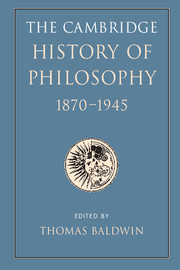Book contents
- Frontmatter
- Contents
- List of contributors
- Introduction
- I 1870–1914
- II 1914–1945
- 8 Logic and philosophy: the analytic programme
- 28 Logical atomism
- 29 The scientific world conception: logical positivism
- 30 The achievements of the Polish school of logic
- 31 Logic and philosophical analysis
- 9 The diversity of philosophy
- 10 Knowledge, language, and the end of metaphysics
- 11 Philosophy and the exact sciences
- 12 Mind and its place in nature
- 13 Philosophy and social science
- 14 Ethics, religion, and the arts
- 15 Law and politics
- Biobibliographical appendix
- Bibliography
- INDEX
- References
29 - The scientific world conception: logical positivism
from 8 - Logic and philosophy: the analytic programme
Published online by Cambridge University Press: 28 March 2008
- Frontmatter
- Contents
- List of contributors
- Introduction
- I 1870–1914
- II 1914–1945
- 8 Logic and philosophy: the analytic programme
- 28 Logical atomism
- 29 The scientific world conception: logical positivism
- 30 The achievements of the Polish school of logic
- 31 Logic and philosophical analysis
- 9 The diversity of philosophy
- 10 Knowledge, language, and the end of metaphysics
- 11 Philosophy and the exact sciences
- 12 Mind and its place in nature
- 13 Philosophy and social science
- 14 Ethics, religion, and the arts
- 15 Law and politics
- Biobibliographical appendix
- Bibliography
- INDEX
- References
Summary
Logical positivism had almost as many names as it had roots. Among the terms used by its promoters were: logical positivism, logical empiricism, scientific empiricism, consistent empiricism, and other, similar names. All these names came fairly late in the day, stemming from around 1930, when the work of the logical positivists was first being brought before the English-speaking philosophical community. The initial public statement by the Vienna Circle, the Wissenschaftliche Weltauffassung: Der Wiener Kreis (Scientific World Conception: The Vienna Circle; Neurath et al. 1929 [1973]), eschews all of these terms, adopting instead the general term ‘scientific world conception’. This term was chosen in self-conscious opposition to the then dominant idealist, conservative, Catholic Austrian Weltanschauung philosophy. The Vienna Circle offered a scientific way of conceiving the world, not an intuitive grasp of the world’s ineffable essence and meaning.
The more general term is useful. It warns us away from expecting to find a short-list of doctrines about which the logical positivists agreed. It reminds us, also, that logical positivism grew up in an Austro-Germanic context. This context provided much of the philosophical training of the logical positivists; it also supplied the arationalist philosophical perspectives, Weltanschauungslehre and Lebensphilosophie (philosophy of life), against which the Vienna Circle publicly situated itself. Thus, while I will here, for ease of reference, employ the term ‘logical positivism’, the reader should bear in mind that this term suggests a greater commonality of project than one actually finds among the logical positivists (for attempts to situate the development of logical positivism within its broader intellectual context, see the essays in Uebel 1991 and Giere and Richardson 1996, as well as Galison 1990; the essential reference work on the career of logical positivism is Stadler 1997).
- Type
- Chapter
- Information
- The Cambridge History of Philosophy 1870–1945 , pp. 391 - 400Publisher: Cambridge University PressPrint publication year: 2003
References
- 2
- Cited by



